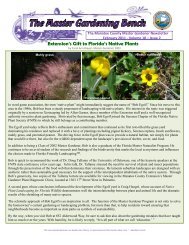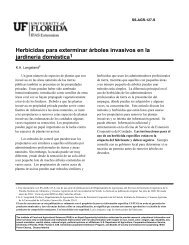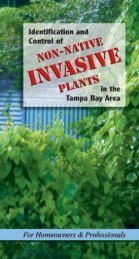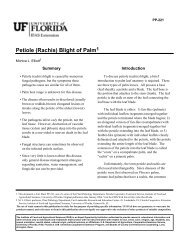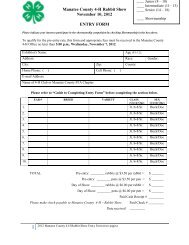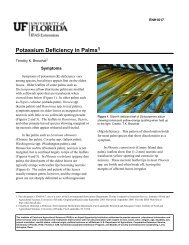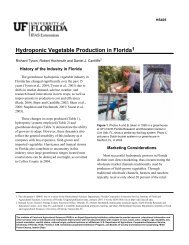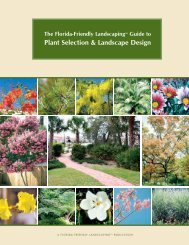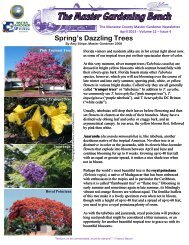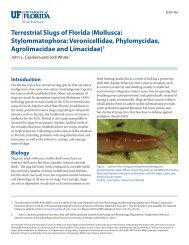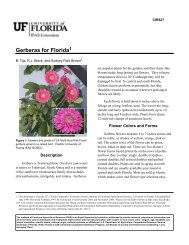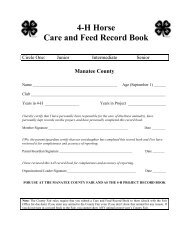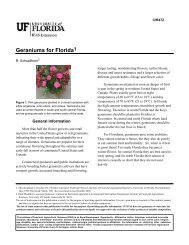Take-All Root Rot - University of Florida
Take-All Root Rot - University of Florida
Take-All Root Rot - University of Florida
You also want an ePaper? Increase the reach of your titles
YUMPU automatically turns print PDFs into web optimized ePapers that Google loves.
Plant Pathology Fact Sheet<br />
PP-31<br />
<strong>Take</strong>-all <strong>Root</strong> <strong>Rot</strong> (referred to as<br />
Bermudagrass Decline on bermudagrass)<br />
Monica L Elliott, Associate Pr<strong>of</strong>essor, Ft. Lauderdale Research and Education<br />
Center, <strong>University</strong> <strong>of</strong> <strong>Florida</strong>, 3205 College Ave, Ft. Lauderdale, Fl 33314 and<br />
Gary W. Simone, Pr<strong>of</strong>essor Emeritus, Plant Pathology Department, <strong>University</strong> <strong>of</strong><br />
<strong>Florida</strong>, Gainesville, <strong>Florida</strong> 32611. Revised April 2001<br />
<strong>Florida</strong> Cooperative Extension Service/ Institute <strong>of</strong> Food and Agricultural Sciences/ <strong>University</strong> <strong>of</strong> <strong>Florida</strong>/ Christine Waddill, Dean<br />
Pathogen<br />
Gaeumannomyces graminis var. graminis<br />
Turfgrasses Affected<br />
<strong>All</strong> warm-season turfgrasses.<br />
Occurrence<br />
The pathogen is naturally present on<br />
turfgrass roots. This disease is primarily observed<br />
during the summer and early fall<br />
months when <strong>Florida</strong> receives the majority <strong>of</strong><br />
its rainfall. Prolonged periods <strong>of</strong> rainfall are<br />
most conducive to this disease. Any stress<br />
placed on the turfgrass will encourage or<br />
worsen the disease.<br />
Symptoms/Signs<br />
This is a root rot disease (Figure 1). Because<br />
the roots are affected, they will not be able<br />
to efficiently obtain water or nutrients from the<br />
soil, nor will they be able to store the products<br />
from photosynthesis. Symptoms observed on<br />
the leaves are the result <strong>of</strong> pathogen activity on<br />
the root system. The fungus does not attack<br />
leaves.<br />
Initial activity <strong>of</strong> the fungus on the roots<br />
will only be observed by looking at the roots.<br />
If the turfgrass is not stressed or under low levels<br />
<strong>of</strong> stress, leaf symptoms may never be observed.<br />
However, under high stress conditions,<br />
symptoms will begin to appear on the leaves.<br />
By the time the leaf symptoms appear, the<br />
pathogen has been active on the roots for at least<br />
2-3 weeks, probably longer.<br />
Initial symptoms above-ground are irregular,<br />
yellow (chlorotic) or light green patches<br />
ranging in diameter from a few inches to a few<br />
feet. <strong>Root</strong>s will initially be thin and <strong>of</strong>f-white<br />
in color with isolated black lesions. Eventually,<br />
roots will become very short, black and<br />
rotted. Stolons and rhizomes may have black<br />
lesions and, under severe disease conditions,<br />
begin to rot. Entire plants may die resulting in<br />
irregular patches <strong>of</strong> thinning grass, and if not<br />
controlled, bare patches may develop (Figures<br />
2 and 3). Using a microscope, black strands <strong>of</strong><br />
fungi (runner hyphae) will be present on outside<br />
<strong>of</strong> roots, stolons and rhizomes, as will special<br />
structures called hyphopodia.<br />
Cultural Controls<br />
This disease is very difficult to control<br />
once the aboveground symptoms are observed.<br />
Therefore, measures that prevent or alleviate<br />
stress are the best methods for completely controlling<br />
the disease or at least decreasing the<br />
potential damage. Stress on turfgrass can result<br />
from many factors and are addressed below.
The turfgrass must be mowed at the correct<br />
height during the summer (Figure 4). It<br />
may even be necessary to raise the mowing<br />
height during periods <strong>of</strong> conducive weather.<br />
The turfgrass must be mowed as frequently as<br />
necessary so that only one third (1/3) <strong>of</strong> the leaf<br />
tissue is removed during any one mowing<br />
event. Scalping the grass damages the growing<br />
point, especially <strong>of</strong> St. Augustinegrass.<br />
Balance nitrogen applications with equal<br />
amounts <strong>of</strong> potassium. For every pound <strong>of</strong> nitrogen<br />
applied, an equal amount <strong>of</strong> elemental<br />
potassium (K) should be applied. Slow-release<br />
nitrogen and slow-release potassium sources<br />
should be used. Avoid nitrate-nitrogen products<br />
and quick-release urea products (e.g., uncoated<br />
urea). If slow-release potassium is not<br />
readily available, then apply quick-release potassium<br />
to the turfgrass between nitrogen applications.<br />
Extra potassium may be useful in<br />
late summer and early fall. Apply micronutrients,<br />
especially manganese. Micronutrients<br />
should be applied in the sulfate form as foliar<br />
applications.<br />
When the disease is active, frequent foliar<br />
(leaf) feeding <strong>of</strong> all nutrients (N, P, K and<br />
micronutrients) in small amounts will be necessary<br />
if the root system is severely damaged.<br />
The roots are not functioning properly, and so<br />
will not be able to efficiently obtain nutrients<br />
from the soil.<br />
Avoid herbicides by learning how to manage<br />
the turfgrass to limit weeds!<br />
Chemical Controls<br />
azoxystrobin, myclobutanil,<br />
propiconazole, thiophanate methyl,<br />
triadimefon<br />
These systemic fungicides are not as<br />
effective as the use <strong>of</strong> cultural controls once<br />
the disease symptoms are observed. These<br />
fungicides may be useful when used preventively.<br />
This means they must be applied prior<br />
to symptom development. Start applying the<br />
fungicides at least one month prior to when<br />
you normally observe aboveground symptoms.<br />
Continue applying once a month until<br />
the weather is no longer conducive for disease<br />
development. It is beneficial to lightly<br />
water-in these fungicides, but it must be done<br />
immediately after application.<br />
Refer to “ Turfgrass Disease Management”<br />
PPP-64 for explanations <strong>of</strong> chemical and<br />
cultural controls.<br />
Do not apply lime to the turfgrass. If you<br />
are growing centipedegrass, it is acceptable to<br />
apply elemental sulfur or iron sulfate to lower<br />
the soil pH below 5.5. Do not do this with other<br />
turfgrasses!<br />
Apply herbicides only as needed and<br />
according to the label. St. Augustinegrass is<br />
especially sensitive to herbicides. Even when<br />
herbicides are applied correctly, there will be<br />
some stress placed on St. Augustinegrass.<br />
Figure 1. St. Augustinegrass roots rotted due<br />
to <strong>Take</strong>-all <strong>Root</strong> <strong>Rot</strong>..
Figure 2.Early above-ground symptoms <strong>of</strong><br />
<strong>Take</strong>-all <strong>Root</strong> <strong>Rot</strong>.<br />
Figure 3. Severe symptoms (death) <strong>of</strong> <strong>Take</strong>all<br />
<strong>Root</strong> <strong>Rot</strong>.<br />
Figure 4. Healthy bermudagrass (green strip<br />
at top) cut at the correct height compared to<br />
severely diseased bermudagrass (bottom) cut<br />
too low.



